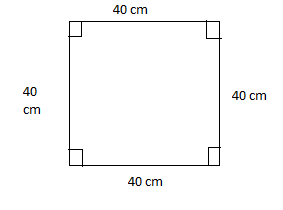
A square and a rectangle have the same perimeter. The side of the square is 40 cm and the length of a rectangle is 10 cm, find a breadth of rectangle.
(A) 80 cm
(B) 90 cm
(C) 70 cm
(D) None
Answer
578.4k+ views
Hint: Let ${P_1}$= perimeter of square and ${P_2}$= perimeter of rectangle; side of square\[S = 40\], length of rectangle$L = 10$and B be the unknown breadth of the rectangle.
Given that ${P_1} = {P_2}$. Use the formulae of perimeter: ${P_1} = 4 \times S$ and ${P_2} = 2 \times (L + B)$
Find B by solving the equation.
Complete step by step answer:
We are given two geometrical figures - a square and a rectangle.
Both have the same perimeter.
We are also given some of their dimensions:
Side of the square = 40 cm

Length of the rectangle = 10 cm.

We are asked to compute the missing dimension of the rectangle, namely, the breadth of the rectangle.
We know that for a square, its perimeter is the sum of all its sides.
A square has 4 sides of equal length.
This gives us the formula for the perimeter of a square.
Perimeter of a square $ = 4 \times side$
Now, a rectangle has 4 sides too. But they are of varying lengths. That is, only the opposite sides are equal.
So, if L denotes the length and B denotes the breadth of a rectangle, then its perimeter is given by the formula: Perimeter of a rectangle \[ = 2 \times (L + B)\]
Call the side of the given square as S and its perimeter as ${P_1}$.
Similarly, call the perimeter of the rectangle as ${P_2}$
Then ${P_1} = 4 \times S$ and ${P_2} = 2 \times (L + B)$
Now we have
\[S = 40\]
Therefore, \[{P_1} = 4 \times S = 4 \times 40 = 160\]
Also, $L = 10$ and $B = ?$ implies that ${P_2} = 2 \times (L + B) = 2 \times (10 + B)$
According to the given condition, the perimeter of the square = perimeter of a rectangle.
$
\Rightarrow {P_1} = {P_2} \\
\Rightarrow 160 = 2 \times (10 + B) \\
\Rightarrow 160 \div 2 = 10 + B \\
\Rightarrow 80 = 10 + B \\
\Rightarrow 80 - 10 = B \\
\Rightarrow 70 = B \\
\Rightarrow B = 70 \\
$
Hence, the breadth of the given rectangle is 70 cm.
Note:
You may come across questions where width is used instead of breadth. However, both mean the same.
Given that ${P_1} = {P_2}$. Use the formulae of perimeter: ${P_1} = 4 \times S$ and ${P_2} = 2 \times (L + B)$
Find B by solving the equation.
Complete step by step answer:
We are given two geometrical figures - a square and a rectangle.
Both have the same perimeter.
We are also given some of their dimensions:
Side of the square = 40 cm

Length of the rectangle = 10 cm.

We are asked to compute the missing dimension of the rectangle, namely, the breadth of the rectangle.
We know that for a square, its perimeter is the sum of all its sides.
A square has 4 sides of equal length.
This gives us the formula for the perimeter of a square.
Perimeter of a square $ = 4 \times side$
Now, a rectangle has 4 sides too. But they are of varying lengths. That is, only the opposite sides are equal.
So, if L denotes the length and B denotes the breadth of a rectangle, then its perimeter is given by the formula: Perimeter of a rectangle \[ = 2 \times (L + B)\]
Call the side of the given square as S and its perimeter as ${P_1}$.
Similarly, call the perimeter of the rectangle as ${P_2}$
Then ${P_1} = 4 \times S$ and ${P_2} = 2 \times (L + B)$
Now we have
\[S = 40\]
Therefore, \[{P_1} = 4 \times S = 4 \times 40 = 160\]
Also, $L = 10$ and $B = ?$ implies that ${P_2} = 2 \times (L + B) = 2 \times (10 + B)$
According to the given condition, the perimeter of the square = perimeter of a rectangle.
$
\Rightarrow {P_1} = {P_2} \\
\Rightarrow 160 = 2 \times (10 + B) \\
\Rightarrow 160 \div 2 = 10 + B \\
\Rightarrow 80 = 10 + B \\
\Rightarrow 80 - 10 = B \\
\Rightarrow 70 = B \\
\Rightarrow B = 70 \\
$
Hence, the breadth of the given rectangle is 70 cm.
Note:
You may come across questions where width is used instead of breadth. However, both mean the same.
Recently Updated Pages
Two men on either side of the cliff 90m height observe class 10 maths CBSE

What happens to glucose which enters nephron along class 10 biology CBSE

Cutting of the Chinese melon means A The business and class 10 social science CBSE

Write a dialogue with at least ten utterances between class 10 english CBSE

Show an aquatic food chain using the following organisms class 10 biology CBSE

A circle is inscribed in an equilateral triangle and class 10 maths CBSE

Trending doubts
Which of the following does not have a fundamental class 10 physics CBSE

State and prove the Pythagoras theorem-class-10-maths-CBSE

Differentiate between Food chain and Food web class 10 biology CBSE

State BPT theorem and prove it class 10 maths CBSE

A Gulab jamun contains sugar syrup up to about 30 of class 10 maths CBSE

Write the difference between soap and detergent class 10 chemistry CBSE




